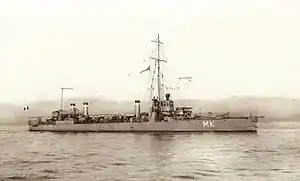Spahi-class destroyer
The Spahi class consisted of seven destroyers built for the French Navy in the first decade of the 20th century. One ship was lost during the First World War, but the others survived to be scrapped afterwards.
 Mameluck at anchor | |
| Class overview | |
|---|---|
| Name: | Spahi class |
| Operators: |
|
| Preceded by: | Claymore class |
| Succeeded by: | Voltigeur class |
| Built: | 1906–1912 |
| In service: | 1910–1930 |
| Completed: | 7 |
| Lost: | 1 |
| Scrapped: | 6 |
| General characteristics | |
| Type: | Destroyer |
| Displacement: | 530–550 t (522–541 long tons) |
| Length: | 64–65.8 m (210 ft 0 in–215 ft 11 in) (p/p) |
| Beam: | 6.05–6.6 m (19 ft 10 in–21 ft 8 in) |
| Draft: | 2.3–2.4 m (7 ft 7 in–7 ft 10 in) |
| Installed power: |
|
| Propulsion: | 2 shafts; 2 triple-expansion steam engines |
| Speed: | 28 knots (52 km/h; 32 mph) |
| Range: | 1,000–1,200 nmi (1,900–2,200 km; 1,200–1,400 mi) at 10 knots (19 km/h; 12 mph) |
| Complement: | 77–79 |
| Armament: |
|
Design and description
The Spahi-class was over 50 percent larger than the preceding Branlebas class to match the increase in size of foreign destroyers. They varied slightly in size due to building practices of each shipyard.[1] They had an length between perpendiculars of 64–65.8 meters (210 ft 0 in–215 ft 11 in), a beam of 6.05–6.6 meters (19 ft 10 in–21 ft 8 in),[2] and a draft of 2.3–2.4 meters (7 ft 7 in–7 ft 10 in). The ships displaced 530–550 metric tons (522–541 long tons) at deep load.[1]
The destroyers were powered by two triple-expansion steam engines, each driving one propeller shaft using steam provided by four water-tube boilers of three different types. Spahi and Lansquenet used Normand boilers, Hussard and Mameluk had du Temple boilers while the remaining three ships were fitted with Guyot boilers. The engines were designed to produce 7,500 indicated horsepower (5,600 kW), except for Spahi with 9,000 ihp (6,700 kW), which was intended to give the sister ships a speed of 28 knots (52 km/h; 32 mph). During their sea trials, they reached speeds of 27.1–29.8 knots (50.2–55.2 km/h; 31.2–34.3 mph). The ships carried 95 t (93 long tons) of coal which gave them a range of 1,000–1,200 nautical miles (1,900–2,200 km; 1,200–1,400 mi) at a cruising speed of 10 knots (19 km/h; 12 mph). Lansquenet had a capacity of 115 t (113 long tons) which gave her a range of 2,880 nmi (5,330 km; 3,310 mi) at the same cruising speed.[3]
The primary armament of the Spahi-class ships consisted of six 65-millimeter (2.6 in) Modèle 1902 guns in single mounts, one each fore and aft of the superstructure and the others were distributed amidships. They were also fitted with three 450-millimeter (17.7 in) torpedo tubes. One of these was in a fixed mount in the bow and the other two were on single rotating mounts amidships.[1]
Ships
| Name | Builder[1] | Laid down | Launched[4] | Completed[4] | Fate[1] |
|---|---|---|---|---|---|
| Aspirant Herber | Arsenal de Rochefort | 30 April 1912 | August 1912 | Condemned, July 1930 | |
| Carabinier | Ateliers et Chantiers de Saint-Nazaire Penhoët, Saint-Nazaire | 10 October 1908 | October 1909 | Scuttled, 15 November 1918 | |
| Enseigne Henry | Arsenal de Rochefort | 12 May 1911 | April 1912 | Condemned, June 1928 | |
| Hussard | Ateliers et Chantiers de la Loire, Nantes | 12 September 1908 | September 1911 | Condemned, March 1922 | |
| Lansquenet | Dyle et Bacalan, Bordeaux | 20 November 1908 | October 1910 | Condemned, December 1928 | |
| Mameluk | Ateliers et Chantiers de la Loire, Nantes | 10 March 1909 | June 1911 | Condemned, February 1928 | |
| Spahi | Forges et Chantiers de la Méditerranée, La Seyne-sur-Mer | 3 May 1908 | July 1910 | Condemned, December 1927 |
Citations
- Gardiner & Gray, p. 202
- Couhat, p. 95
- Couhat, pp. 95–96
- Couhat, p. 96
Bibliography
| Wikimedia Commons has media related to Spahi-class destroyer. |
- Couhat, Jean Labayle (1974). French Warships of World War I. London: Ian Allan. ISBN 0-7110-0445-5.
- Gardiner, Robert & Gray, Randal (1985). Conway's All The World's Fighting Ships 1906–1921. London: Conway Maritime Press. ISBN 0-85177-245-5.
- Osborne, Eric W. (2005). Destroyers - An Illustrated History of Their Impact. Santa Barbara, California: ABC-Clio. ISBN 1-85109-479-2.
- Roche, Jean-Michel (2005). "Classement par types". Dictionnaire des bâtiments de la flotte de guerre française de Colbert à nos jours 2, 1870 - 2006. Toulon: Roche. ISBN 978-2-9525917-0-6. OCLC 165892922.
